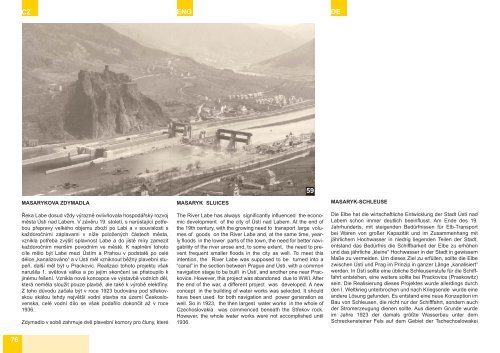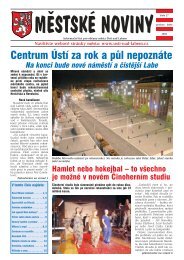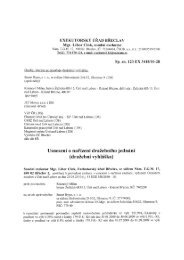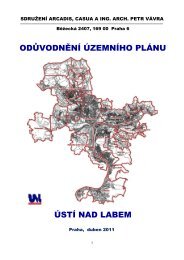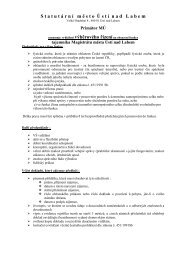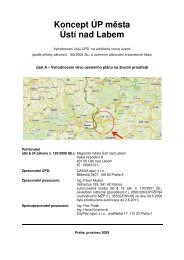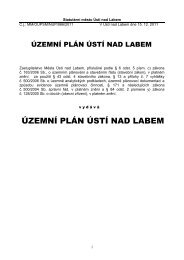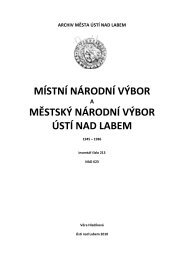Historie a památky města Ústí nad Labem History and monuments of ...
Historie a památky města Ústí nad Labem History and monuments of ...
Historie a památky města Ústí nad Labem History and monuments of ...
Erfolgreiche ePaper selbst erstellen
Machen Sie aus Ihren PDF Publikationen ein blätterbares Flipbook mit unserer einzigartigen Google optimierten e-Paper Software.
76<br />
CZ ENG DE<br />
MASARYKOVA ZDYMADLA<br />
Řeka Labe dosud vždy výrazně ovlivňovala hospodářský rozvoj<br />
<strong>města</strong> <strong>Ústí</strong> <strong>nad</strong> <strong>Labem</strong>. V závěru 19. století, s narůstající potřebou<br />
přepravy velkého objemu zboží po Labi a v souvislosti s<br />
každoročními záplavami v níže položených částech <strong>města</strong>,<br />
vznikla potřeba zvýšit splavnost Labe a do jisté míry zamezit<br />
každoročním menším povodním ve městě. K naplnění tohoto<br />
cíle mělo být Labe mezi <strong>Ústí</strong>m a Prahou v podstatě po celé<br />
délce „kanalizováno“ a v <strong>Ústí</strong> měl vzniknout běžný plavební stupeň,<br />
další měl být u Prackovic. Realizaci tohoto projektu však<br />
narušila 1. světová válka a po jejím skončení se přistoupilo k<br />
jinému řešení. Vznikla nová koncepce ve výstavbě vodních děl,<br />
která neměla sloužit pouze plavbě, ale také k výrobě elektřiny.<br />
Z toho důvodu začala být v roce 1923 budována pod střekovskou<br />
skálou tehdy největší vodní stavba na území Československa,<br />
celé vodní dílo se však podařilo dokončit až v roce<br />
1936.<br />
Zdymadlo v sobě zahrnuje dvě plavební komory pro čluny, které<br />
MASARYK SLUICES<br />
59<br />
The River Labe has always significantly influenced the economic<br />
development <strong>of</strong> the city <strong>of</strong> <strong>Ústí</strong> <strong>nad</strong> <strong>Labem</strong>. At the end <strong>of</strong><br />
the 19th century, with the growing need to transport large volumes<br />
<strong>of</strong> goods on the River Labe <strong>and</strong>, at the same time, yearly<br />
floods in the lower parts <strong>of</strong> the town, the need for better navigability<br />
<strong>of</strong> the river arose <strong>and</strong>, to some extent, the need to prevent<br />
frequent smaller floods in the city as well. To meet this<br />
intention, the River Labe was supposed to be turned into a<br />
“canal” in the section between Prague <strong>and</strong> <strong>Ústí</strong>, with a common<br />
navigation stage to be built in <strong>Ústí</strong>, <strong>and</strong> another one near Prackovice.<br />
However, this project was ab<strong>and</strong>oned due to WWI. After<br />
the end <strong>of</strong> the war, a different project was developed. A new<br />
concept in the building <strong>of</strong> water works was selected. It should<br />
have been used for both navigation <strong>and</strong> power generation as<br />
well. So in 1923, the then largest water works in the whole <strong>of</strong><br />
Czechoslovakia was commenced beneath the Střekov rock.<br />
However, the whole water works were not accomplished until<br />
1936.<br />
MASARYK-SCHLEUSE<br />
Die Elbe hat die wirtschaftliche Entwicklung der Stadt <strong>Ústí</strong> <strong>nad</strong><br />
<strong>Labem</strong> schon immer deutlich beeinflusst. Am Ende des 19.<br />
Jahrhunderts, mit steigenden Bedürfnissen für Elb-Transport<br />
bei Waren von großer Kapazität und im Zusammenhang mit<br />
jährlichem Hochwasser in niedrig liegenden Teilen der Stadt,<br />
entst<strong>and</strong> das Bedürfnis die Schiffbarkeit der Elbe zu erhöhen<br />
und das jährliche „kleine“ Hochwasser in der Stadt in gewissem<br />
Maße zu vermeiden. Um dieses Ziel zu erfüllen, sollte die Elbe<br />
zwischen <strong>Ústí</strong> und Prag im Prinzip in ganzer Länge „kanalisiert“<br />
werden. In <strong>Ústí</strong> sollte eine übliche Schleusenstufe für die Schifffahrt<br />
entstehen, eine weitere sollte bei Prackovice (Praskowitz)<br />
sein. Die Realisierung dieses Projektes wurde allerdings durch<br />
den I. Weltkrieg unterbrochen und nach Kriegsende wurde eine<br />
<strong>and</strong>ere Lösung gefunden. Es entst<strong>and</strong> eine neue Konzeption im<br />
Bau von Schleusen, die nicht nur der Schifffahrt, sondern auch<br />
der Stromerzeugung dienen sollte. Aus diesem Grunde wurde<br />
im Jahre 1923 der damals größte Wasserbau unter dem<br />
Schreckensteiner Fels auf dem Gebiet der Tschechoslowakei


